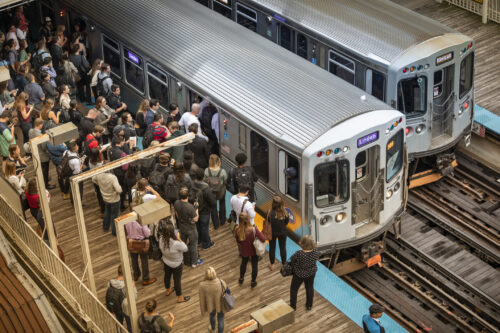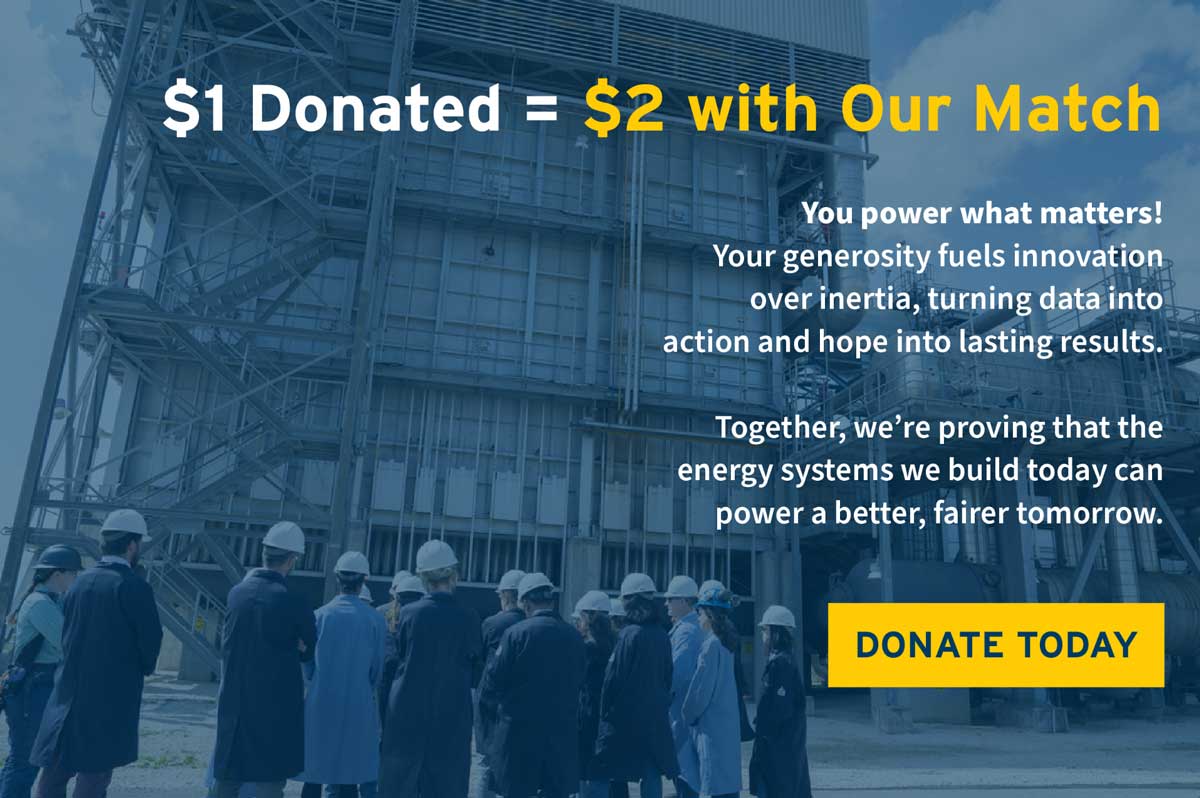Chicago, Illinois, USA - September 24, 2018: Commuters wait on the platform for the elevated train on the tracks in the Loop area of downtown Chicago Illinois USA

Building Smarter: How Investing in More Transportation Choices Cuts Infrastructure Costs
At a time when decision makers are struggling to balance state budgets, new research demonstrates that multimodal infrastructure investments can reduce transportation expenditures in the long run by more affordably serving urban travel demand.
Last month, Illinois lawmakers brought the Chicago transit system back from the brink of financial insolvency largely by deploying one transformative solution: shifting transport revenues away from excess roadway construction and instead into turbocharging the region’s trains and buses.
This groundbreaking measure comes at a time when Americans are experiencing soaring transportation costs and congestion, and when funding for affordable solutions to skipping traffic is drying up. Transit agencies across the United States are staring down crippling service cuts, and federal programs to support walkable neighborhoods and convenient commuting options are being pulled back. However, Illinois and other far-sighted states are taking bold actions to deliver relief to their commuters now.
New analysis from the nonprofit, non-partisan Institute for Transportation and Development Policy (ITDP) shows that, if the rest of the country followed Illinois’s example and repurposed larger shares of their transportation expenditures into “multimodal” solutions, like bus, rail, and biking, governments could collectively save $1 trillion in public expenditures by 2050 while also better serving urban travel demand.
Exhibit 1: By spending more on cost-effective, multimodal solutions, decision makers can reduce the need to construct and maintain as many urban roadways, unlocking net expenditure savings while also providing commuters with more affordable choices.
The ITDP analysis compares two scenarios, represented in Exhibit 1. In the Business as Usual (BAU) Pathway, national transportation investments continue to focus on highway expansion, increasing traffic and the need to drive. This trend is reflected in the fact that despite significant investments in widening freeways, drivers are losing an all-time high of 63 hours a year — more than a typical work week — sitting in gridlock. More than just wasting drivers’ time, these trends also encourage development patterns that spread housing and services farther apart, thus requiring more tax dollars to construct and maintain more pavement.
However, we have the technology today to slash congestion and move more people per dollar by leveraging 21st-century public transit and active transportation solutions. The Multimodal Investment Pathway assumes that metro regions, to the maximum extent feasible, invest in projects that give commuters more affordable choices — bus, rail, and biking infrastructure. In this scenario, we find that state budgets would save on average 10 percent of their annual transportation expenditures due largely to savings from roadway spending focused on maintaining existing infrastructure.
How much would your state save by building out a complete network of buses, active transportation, and passenger rail?
RMI partnered with the ITDP study authors to localize the study’s results to each of the 50 US states. The state-level lens is key, because, as demonstrated by Illinois, state decision makers have significant influence over how both federal and local transportation dollars are spent in their community. Projected savings by state, which also assume smart co-location of housing and mixed-use development near the new mobility networks, are available in Exhibit 2 below.
The scale of these benefits is staggering, with states like Michigan and Pennsylvania each standing to save a billion dollars per year on average. However, when considered in the context of what these states historically spend on transport in a year, these values represent achievable reductions in spending. The color key in Exhibit 2 relates the savings as a proportion of state transport spending in 2022.
The extent of the multimodal networks called for may appear ambitious, but they are feasible given the long-term time horizon of the analysis (2015-2050). For example, in the two decades since 2003, Washington state built 47 miles of Link Light Rail from scratch. Looking forward, the state has funded plans to double the system’s length to 116 miles by 2044, or by approximately the same amount analyzed in our study, proving that constructing these cost-saving, multimodal networks is feasible given planning foresight.
But these infrastructure savings don’t happen by accident — they are activated by bold, target-driven policy frameworks. Whether you’re solving for fiscal responsibility, climate goals, or traffic reduction, states have multiple tools available to unlock the benefits of expanded transportation choices.
Virginia reimagines transportation spending to be more multimodal, attracts $2.5 billion Amazon investment
Virginia, which is considered the number one state in the country for business and enjoys below-average taxes, redesigned its Department of Transportation (DOT) planning processes in 2014 to prioritize the highest “return on investment” infrastructure projects. The program, called SMART SCALE, scores projects on a range of priority factors, including land use and economic development. The scores are weighted differently in different regions, reflecting the unique needs of urban, suburban, and rural areas.
As shown by the chart below, Commonwealth spending on rail transit, bus transit, and active transportation more than tripled as a proportion of state spending in the years following the program’s launch as planners came to realize the economic opportunity of multimodal strategies in urban areas especially.
Exhibit 3: Spending on rail, bus, active transportation and travel demand management increased substantially as result of the SMART SCALE program, demonstrating the impact of the program towards prioritizing cost-effective mobility solutions.
Nearly a decade later, Virginia is cashing in on the advantages of its nation-leading program to make its cities more walkable and transit-rich. Access to transportation choices was a main selection criterion for Amazon’s decision to locate its $2.5 billion HQ 2.0 in Arlington, which boasts three Metrorail stations, 14 bus routes, and hundreds of miles of bikeable trails that have benefited from SMART SCALE investment.
This is the virtuous cycle of multimodal spending in action — new access to mobility choices raises property values, which in turn increases the tax base and quality of county services. Top-notch services, such as Arlington’s nation-leading schools, attract and retain top-notch talent — the exact kind of employees that companies like Amazon are looking to hire.
While Virginia has room to improve, the state’s embrace of multimodal strategies is well underway — and according to our analysis, this pathway could help the Commonwealth save $820 million per year on average, keeping taxes low and spurring even more economic activity.
Illinois saves billions in economic activity by shifting road dollars to fund transit operations
Earlier this year, the Chicago metro area faced a transit death spiral. Despite being one of the top 10 fastest-growing metros in the country, out-of-date funding structures led to local transit agencies announcing 40% service cuts and route suspensions set to start in summer 2026. Decreasing transit availability tends to degrade ridership, which would have lead to even more funding challenges as revenue-generating trips are canceled or shifted to privately owned vehicles.
Researchers warned that service cuts would inflict massive costs on taxpayers, even for those who only drive. MIT and Argonne National Laboratory, for example, projected that if the region’s transit were to shut down entirely, new car trips would gridlock the Windy City, increasing travel times by 35% and strangling productivity.
Per the study, new congestion and increased car costs would also lead to the cancellation of millions of economically productive trips, adding up to $35 billion in annual losses for the region. These costs did not include the public health impacts of more tailpipe pollution and automobile crashes.
Exhibit 4: Researchers from MIT/Argonne find that shuttering Chicago region transit would significantly disrupt the local economy by gridlocking roadways and raising household vehicle ownership costs.
Fortunately, Illinois lawmakers launched a last-ditch effort to save the system in October. In an approach similar to the investment shift discussed in this blog, the legislature largely avoided raising new taxes and instead diverted excess roadway revenues to sustainably fund transit operations. By taking additional steps to expand the Chicago region’s transit system, we find that the state could save $1.4 billion in average annual expenditures while also increasing the region’s affordability and economic competitiveness.
The benefits of multimodal investment are within reach – if decision makers act now
The data is clear: doubling down on multimodal investments not only reduces traffic, but it can also lower costs for governments and taxpayers alike. With Illinois and Virginia as clear examples, decision makers must decide if their states will leverage multimodal investments to turbocharge their urban economic centers or risk leaving their commuters behind in endless brake lights and car payments.
Made in collaboration with ITDP and Ives Street Planning Analytics. The original analysis methodology is available here.
